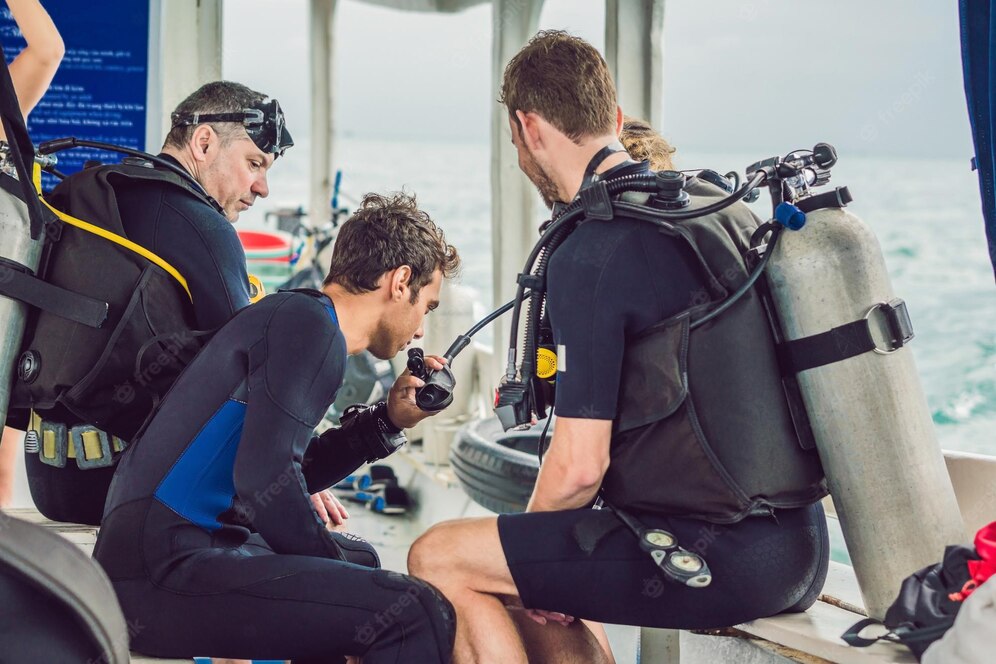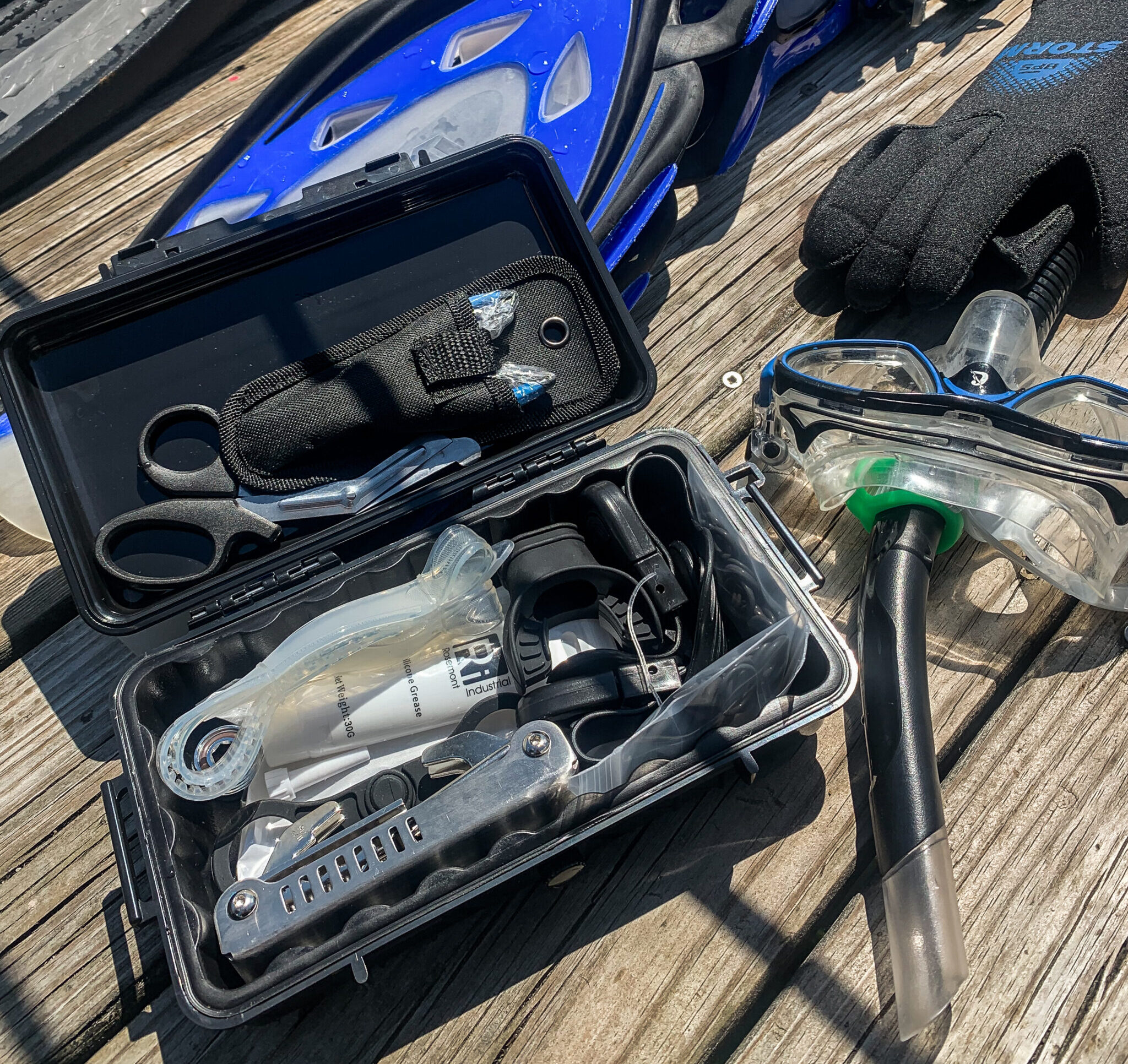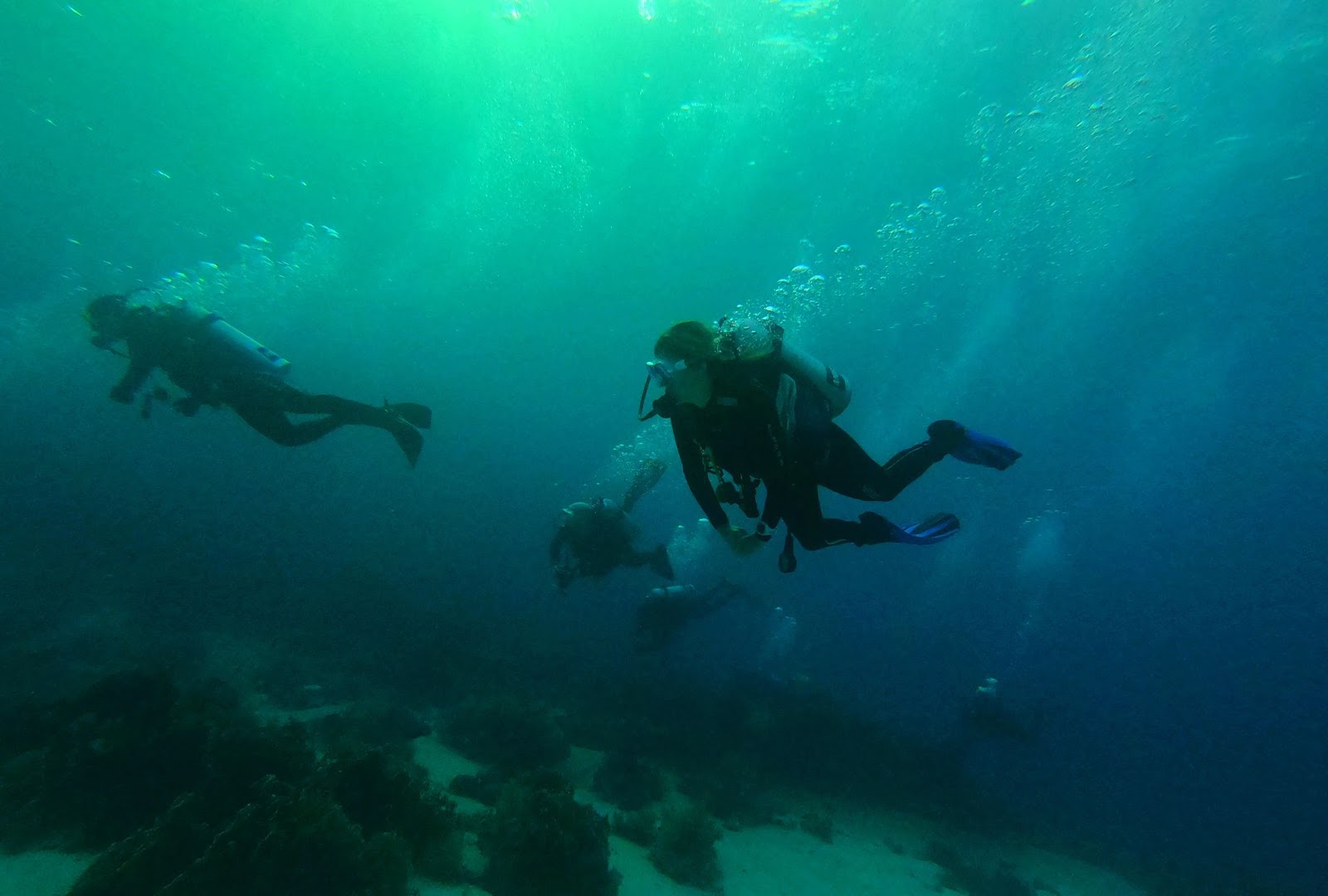10 Items Every Beginning Scuba Diver Must Have

- June 5, 2022
- , 2:59 pm
10 Items Every Beginning Scuba Diver Must Have: Essential Scuba Diving Accessories
If you’re new to diving, the task of assembling your dive gear can be daunting. You may already have a mask, fins, Buoyancy Control Device (BCD), and maybe even a regulator. But what scuba diving accessories should you add to your scuba diving bag? Here is a list of 9 essential dive gear accessories that every beginner scuba diver should have in their dive gear arsenal. This will get you started on the right foot and ensure that you’re properly equipped for your underwater adventures with the best scuba gear!
You have the basics covered, now what scuba diving accessories should I add to my dive bag?
One of the biggest challenges and greatest joys of scuba diving is all of the accessories and gear options. To a beginner, all the options can be overwhelming. So we have created a list to help guide you to the must-have accessories every beginner scuba diver should have when they go out on the water to scuba dive.
#1 – A Dive Computer: a must-have!
Without a doubt, an essential accessory is a dive computer. A dive computer helps you to keep track of your depth, time, and air supply while you’re diving. It’s a valuable tool, especially for beginner scuba divers. Dive computers come in a variety of shapes and sizes with tons of different features. Do some research to find the perfect dive computer for your needs. I believe that your first dive computer should not be super expensive. Most basic dive computers get you 90% of the benefit of having a dive computer and are not hard on the budget. Key benefits of a dive computer are:
- Longer bottom time – By calculating your actual dive profile, you get additional bottom time than if you were to use the navy dive tables.
- Safe assents – Almost every dive computer will either beep or provide you visual feedback on your assent rate – helping you keep your ascent back to the surface safe and help limit the risks of decompression sickness ‘the bends’ or other barotrauma injuries that can result from the over-expansion of gas if you ascent too quickly.
- Act as a logbook – Every dive computer will record your dive and at a minimum include data like dive time, and max depth. Fancy dive computers will add additional elements like complete visualization of your dive profile, water temperatures, sac rates, etc…
- Repetitive Dive Profiles – The computer will track your off-gassing of nitrogen and calculate your risk of decompression illness.
- Max Depth calculation for Nitrox – Most dive computers also have functions for handling nitrox and providing you with the max depth calculation based on the gas mix you are using.
#2 – Save-A-Dive Kit: Don’t miss out on a dive because of simple equipment failure.
What is a save-a-dive kit? A save-a-dive kit is a handy collection of spare scuba diving parts and tools. This scuba diving accessory is a must-have! Nothing is more frustrating than getting out to a dive site or on the dive boat only to find out as you are setting up your equipment that you have a leaky o-ring on your scuba tank or regulator, a broken mask or fin strap, or some other easily fixable equipment failure. A Typical save a dive kit will have at a minimum the following items:
- Basic tools – like screwdrivers, wrenches, allen keys, and pliers.
- O-Rings – one of the most common scuba diving gear failures is a blown or leaky O-Ring. Make sure you have a good variety of sizes
- Basic Replacement Parts: Critical items for your save-a-dive kit include, an additional mouthpiece for your scuba regulator, a spare scuba mask, and a fin strap.
- Other items: Some additional items like clips to connect or attach other gear, zip ties, and surgical scissors are all useful additions.
- Customize it: Based on the type of scuba diving you do and the type of equipment you have you will need to add into your save-a-dive kit any other useful extra pieces and parts or tools that make sense to you.
Never miss a dive because of basic equipment failure that can be easily fixed with a well-appointed save-a-dive kit.
#3 – Cutting Tool: Get out of sticky situations!
A cutting tool is an essential scuba diving accessory You never know when you might need to cut yourself free from something underwater. There are a couple of typical options for scuba diving cutting tools, the most common of which are:
- Dive Knife: A dive knife can be used for a variety of tasks underwater, including cutting lines, prying, and even defending against aggressive fish. Dive knives come in many different shapes and sizes. From blunt tips to pointed tips, serrated blades to straight blades, there is a dive knife out there for every scuba diver.
- Line Cutter – A line cutter is a specialized cutting tool that is designed specifically for cutting fishing lines. Line cutters are small, compact, and easily attached to your BCD or weight belt.
- Shears – Scuba diving shears are perhaps the most versatile cutting tool a scuba diver can carry. Shears can be used to cut just about anything are compact and typically safe and easy to operate.
#4 – Signaling Device: stay safe and be seen
Whether you’re diving in open water or on a crowded reef, it’s important to have a signaling device with you at all times. A signaling device can help you to attract attention if you get lost or separated from your group. Some common signaling devices are:
- Whistles – A dive whistle is an essential piece of scuba diving safety gear. All scuba divers should have a whistle attached to their BCD. you want to look for one that generates over 120DB to help alert others to your location.
- Surface marker buoys (SMBs) – A surface marker buoy (SMB) is an inflatable tube that scuba divers use to mark their location on the water’s surface. SMBs come in a variety of sizes, from small one-person tubes to large multi-person rafts.
#5 – Dive Light: make your dive experience brighter
A dive light is essential for night dives or diving in dark murky waters and can also be used to signal for help. Some scuba divers opt for a headlamp-style dive light so their hands are free, but be careful with these since many dive lights today are very bright you need to be careful you do not blind your dive buddy when looking at them. Hand-mounted dive lights are another option, freeing up your hand while still being able to point and use it comfortably. When choosing a dive light, you want to look for one that is:
- Bright – Look for a dive light that has an output of at least 1000 lumens. If you plan to use a dive light during the day in fairly clear water to look into nooks and crannies or signal interesting things to your dive buddy you might want to consider a 2000 lumen light.
- Waterproof – All scuba diving lights should be waterproof. Look for dive lights with an IPX8 rating. This is a good choice for anyone who needs the light to be underwater for long periods of time and at more extreme depths, as well as anyone wanting the highest level of water protection. Lights with the IPX8 rating will have an icon with a specified depth typically listed in meters.
#6 – Dive Compass: get back to where you started
A dive compass is another essential tool for scuba diving, especially if you’re planning on doing any navigation during your dive. Some of you may already have a compass as part of your console attached to your scuba regulator, but many of the newer consoles are going for a slimmer and sleeker look and no longer have the compass as part of the standard console. Compasses come in both analog and digital versions. Many of the feature-rich dive computers already have a digital compass as part of the package. For a beginner, an analog compass will do. Look for the following features:
- Rotating bezel – The bezel is the outer ring of the compass that you rotate to take a bearing.
- Lubber line – This is a line that is perpendicular to the dial of the compass. It helps you to read the compass while you’re moving.
- Index Marks – These are the lines on the bezel that you line up with the lubber line to take a bearing.
- Side Window – This is a small window on the side of the compass that you can use to take a bearing without having to hold the compass level.
#7 – Logbook: keep track of your memories
A logbook is a valuable way to keep track of your scuba diving experiences. Be sure to include the date, time, location, and conditions of each dive. It does not matter if you capture your logs digitally or on paper, it is important to keep track of your dives. Many liveaboards and some dive tour operators will want to see your logbook to ensure you are qualified for the experience they are taking you on.
- Digital Logbook – You can keep track of your scuba diving experiences using a digital logbook. This is a great option for those who want to be able to access their records at any time or anywhere.
- Paper logbook – You can also keep track of your scuba diving experiences using a paper logbook. This is a great option for those who want to have a physical record of their dives.
#8 – Dive Bag: keep all your dive gear organized
Finding the right dive bag is a bit of a challenge. You want one that protects your gear is well ventilated and easy to carry. A dive bag is essential for storing and transporting your scuba diving gear. Choose a bag that’s large enough to fit all of your gear, but not so large that it’s cumbersome to carry. There are many dive bag options – find the right one for you, typical styles include a backpack, duffel, cargo, and roller style bags.
- Mesh – typically mesh bags are the cheapest and overall do a great job allowing you to transport your gear wet or dry. they tend not to last many years as they lack durability. Consider one with good strong straps.
- Travel bags – are usually much more durable as they are designed to protect your gear on flights. As a result, they are often heavier but will usually have rolling wheels and handle or even backpack straps.
#9 – Clips & Lanyards: Keep your gear on you; not on the bottom
Secure all of your scuba gear with the right clips and lanyards to keep organized, and streamlined and make sure everything is accessible. Clips and lanyards for scuba diving are usually constructed out of plastic, stainless steel, or brass. Plastic clips are often lightweight and moderately durable, and prone to breakage as they age, as the plastic degrades over time in the sun and sea. Stainless is typically the best material especially if you plan to do a lot of diving in saltwater. It comes in a variety of different types with 304 stainless having moderate rust resistance in saltwater but 316 stainless steel which is usually called marine grade stainless steel. Brass is often used in marine environments, and is rust-resistant, but will tend to oxidize – get a green powder that will make clips sticky. I prefer 316 stainless for most of my clips. There are many clip types, here are a few of the most common ones.
- Retractors – retractor type clips keep your gear organized and close by but allow you to extend it out when diving. This is helpful to keep items like dive lights for night diving and underwater camera close but easy to extend while staying secure.
- Bolt Clips – bolt clips come in many different styles and sizes, they are very useful to attach items to your BCD while diving. Single barrel bolt clips with a rine are useful for attaching loose items. Double barrel bolt clips are great for attaching anything from your dive console, your SMB, and reel to your octo to your BCD.
- Velcro clips – are often lightweight and do a really good job of making items secure. Just not they can be harder to operate with gloves.
- Lanyards – these are cords or straps that are used to connect your scuba heat. Often they will have stainless steel rings or plastic clips on the end to secure items for you.
#10 Reef Safe Sunscreen – protect yourself and the reef!
Whether you’re swimming, diving, or simply lounging on the beach, the sun’s rays can be overpowering. You may rapidly get sunburned if you don’t use sunscreen that is safe for your aquatic system. Did you realize, however, that traditional sunscreen poses a risk to our underwater environment? Many sunscreens contain chemicals that are toxic to corals and other marine life. When these chemicals enter the water, they can cause bleaching and other diseases in corals. They can also disrupt the delicate balance of the marine food chain. Reef Safe sunscreen uses natural ingredients that are gentle on both your skin and the environment. So the next time you pack your beach bag, make sure to include a tube of Reef Safe sunscreen!
Since the term reef safe isn’t a regulated term, you cannot always trust that the sunscreen you are using is truly reef safe. So make sure to check the ingredients of your sunscreen against the HEL List – which is a list of chemicals that are known pollutants. here are the key chemicals to avoid:
- Any form of microplastic sphere or beads.
- Any nanoparticles like zinc oxide or titanium dioxide.
- Oxybenzone
- Octinoxate
- 4-methylbenzylidene camphor
- Octocrylene
- Para-aminobenzoic acid (PABA)
- Methyl Paraben
- Ethyl Paraben
- Propyl Paraben
- Butyl Paraben
- Benzyl Paraben
- Triclosan
As a beginner scuba diver, it’s important to have the proper gear and scuba diving accessories with you on each dive. By following this list, you’ll be sure to have everything you need for a safe and enjoyable diving experience. Happy diving!
Share With Friends
Related Post

10 Items Every Beginning Scuba Diver Must Have
Find out the top 10 items and accessories we recommend that every beginning scuba diver has as part of their scuba gear.

Why you need a save-a-dive kit
You cannot prevent all equipment failures you can make sure



 BY ROSEMONT INDUSTRIES
BY ROSEMONT INDUSTRIES